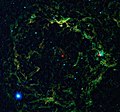| Molecular cloud | |
|---|---|
| Molecular cloud complex | |
 Part of the Orion molecular cloud complex, with the Great Nebula in Orion near the center, along with the Belt of Orion, and Barnard's Loop curling around the image | |
| Observation data: J2000.0 [1] epoch | |
| Right ascension | 05h 35.3m [1] |
| Declination | −05° 23′ [1] |
| Constellation | Orion |
| Designations | Orion complex, Orion cloud complex, Orion molecular cloud complex |
The Orion molecular cloud complex (or, simply, the Orion complex) is a star-forming region with stellar ages ranging up to 12 Myr. Two giant molecular clouds are a part of it, Orion A and Orion B. The stars currently forming within the complex are located within these clouds. A number of other somewhat older stars no longer associated with the molecular gas are also part of the complex, most notably the Orion's Belt (Orion OB1b), as well as the dispersed population north of it (Orion OB1a). Near the head of Orion there is also a population of young stars that is centered on Meissa. The complex is between 1 000 and 1 400 light-years away, and hundreds of light-years across.
Contents
- Nebulae within the complex
- Individual components
- Orion A
- Orion B
- Orion OB1 association
- Lambda Orionis molecular ring
- Superbubble
- Gallery
- See also
- References
- External links
The Orion complex is one of the most active regions of nearby stellar formation visible in the night sky, and is home to both protoplanetary discs and very young stars. Much of it is bright in infrared wavelengths due to the heat-intensive processes involved in stellar formation, though the complex contains dark nebulae, emission nebulae, reflection nebulae, and H II regions. The presence of ripples on the surface of Orion's molecular clouds was discovered in 2010. The ripples are a result of the expansion of the nebulae gas over pre-existing molecular gas. [2]
The Orion complex includes a large group of bright nebulae and dark clouds in the Orion constellation. Several nebulae can be observed through binoculars and small telescopes, and some parts (such as the Orion Nebula) are visible to the naked eye.












